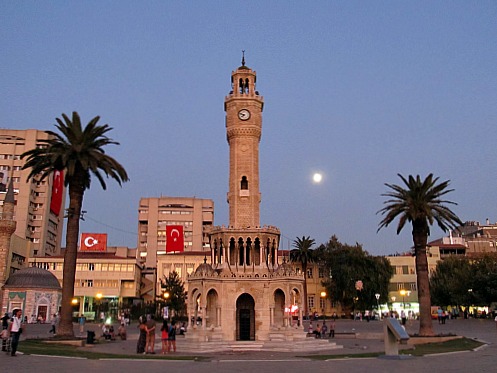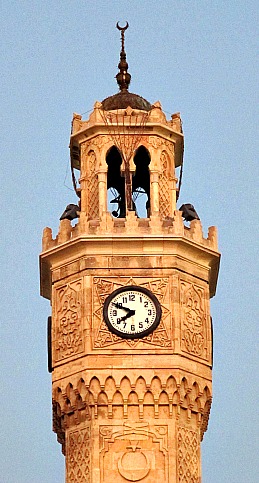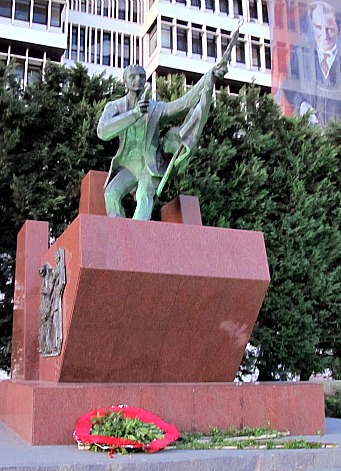Before we could go shopping, though, we had to take care of important business. There was still that battery charger to find.
By now, Gino had been drastically curtailing his usual rampant video-taking. Knowing he was running on battery fumes, he had become extremely picky about what he filmed. We still had Ephesus coming up, and at the end, Bodrum.
A block from our hotel we found an actual Sony store. In creative sign language we explained what we needed. No, sorry, they didn’t sell parts like that. But there was another store that surely would — the Sony repair store. Perfect!
The friendly clerk drew us a map, wrote down the address, and described how to get there on foot. “But wait,” we said. “Would you mind calling them first to make sure they have what we need?”
They called. And called. Finally, they were told that this particular store is closed on Saturdays. Today was Saturday. They wouldn’t be open tomorrow either. We were done.
We resigned ourselves to having little and no video for the remainder of the trip and accepting this sad reality, walked off towards the market. What better way to lose our frustration than in the colorful tangles of a Turkish bazaar?

One of the things you’ll notice in Turkey is the proliferance of evil eyes (stop for a moment and click here to read my page on these prolific Mediterranean symbols).
Not surprisingly, one of the first things we saw as we entered the Kemeralti, Izmir’s smaller version of Istanbul’s Grand Bazaar, was a small shop dedicated entirely to evil eyes. It was so small it was difficult to get inside to really look around so we lingered at the opening, looking at the different evil eye creations hanging there.
Before seriously devoting ourselves to Kemaralti, we stopped for lunch at a small cafe inside the market for a stuffed potato snack. The young fellow who waited on us was very sweet. He was quite intrigued when he learned we were from California.
“Very thank you!” he said, after I paid the bill.
I asked him where I might find the rice pudding I’d been searching for since the Galata Tower in Istanbul. He drew a little map showing us how to get to a pudding shop, then decided just to leave his post and lead us around the corner to point it out. The name of the shop was BHU, short for Bolulu Hasan Usta.

This rice pudding, called firinda sütlaç, was well worth the wait. A classic rice pudding from Ottoman cooking, it is moist and creamy and a bit burnt on the top, the same way that crème brûlée is. I ate every drop.
Now it was time to shop. We admired the European style shoes in the windows, even trying some on. The ubiquitous carpet hawkers tried to lure us into their shops. But by now, we were adept at avoiding them.
“Espanol!” they called out to Gino. “Australian!” they yelled. One queried, “Italian?” Not breaking my stride, I responded in Italian and was surprised when he answered back in perfect Italian. The man and I bantered back and forth for as long as we could hear each other’s words.
Gino and I came up with a giggly idea that would be a perfect come-back to the carpet hawkers. We would simply respond in a made-up language, gibberish, but spoken as though it were real. That would take them aback…at least for a second.
We passed a Turkish tea spot with characteristic low tables and chairs covered with carpets and colorful cloth. Tall narghiles sat next to the tea-making equipment. It all looked very enticing. We sat down.

What timing! Two musicians were seated at the table behind us, one playing a violin, and the other playing a doumbek and singing. How much more Turkish could this get — sitting in a bazaar, having tea, with live music at the next table!

We continued exploring the bazaar which flowed outward into a warren of streets hiding swirls of treasures: brass and other metal items hanging from windows, clothing of every kind, jewelry, pottery, sparkly colored glass lamps, scarves, fabric, and food. It made me delightfully dizzy.



One food cart was filled with prickly pears. A man with a long knife was peeling off the spiky skin for passersby.


An old woman sat on the ground with a tarp spread with nuts for sale. On a corner, I spotted a mannequin of a young boy dressed in full regalia for his circumcision day, little king for a day.

At the outer edge of the market, we stumbled upon a bead store. It was filled with evil eyes of every size and metal findings of every design. I filled my hands with a mound of them, large and small, and when I paid, it amounted to practically nothing.
Finally, having had our fill of shopping, we wandered away from the market towards the seafront. Without even trying, we found ourselves in a huge open area which turned out to be Konak, the very heart of Izmir.

































